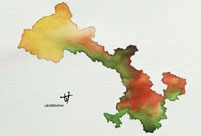 Motorcycle stunt on the Bund
Motorcycle stunt on the Bund
 French Spiderman Alain Robert climbs up Galaxy Hotel in Macao
French Spiderman Alain Robert climbs up Galaxy Hotel in Macao
 Africans in Guangzhou
Africans in Guangzhou
 Pole dancer shows strength and beauty up in the air
Pole dancer shows strength and beauty up in the air
 College girls call for protection of ecological space on earth
College girls call for protection of ecological space on earth
 Top 10 celebrities driving auto brands
Top 10 celebrities driving auto brands
 10 low-carbon tips to save money
10 low-carbon tips to save money
 Luxury cars make Asia premiere at Auto China
Luxury cars make Asia premiere at Auto China
 Versatile dog
Versatile dog
 Ni Ni covers BAZAAR JEWELRY
Ni Ni covers BAZAAR JEWELRY
Unearthed files provide new details of Japan's occupation, report He Na and Dong Fangyu from Changchun.
In 1990, Zhao Yujie, a young teacher of Japanese at a high school, decided to fully exploit her linguistic skills by applying for a job at Jilin Provincial Archives.
Although she wasn't aware of the fact, Zhao had applied at exactly the right time. The management of the archives was searching for Japanese speakers to help decipher a huge number of records, totaling about 100,000 documents, made by the Japanese and detailing the activities of the Imperial Army during the occupation of China.
Recently, 89 of the 100,000 files discovered in Changchun, the provincial capital, have been made available to the public for the first time. The documents were buried following Japan's surrender in August 1945. At the time, Changchun, then called Hsingking, was the capital of the Japanese-controlled puppet state of Manchukuo, which covered most of Manchuria.
Eighty-seven of the files describe the activities of Kwantung Kempeitai, or military police corps, while the other two detail the work of the Manchukuo central bank. Because around 90 percent of the files were written in Japanese, the words, photos, audio material and blueprints provide clear descriptions of the behavior of the Japanese troops in the period 1931 to 1945.
The documents provide insights into Japan's invasion, its battle plans and colonization strategies, and key episodes such as the Nanjing Massacre, the use of sex slaves, or "comfort women" as they were known, bacteriological experiments on prisoners and civilians, suppression of an anti-Japanese army in China's Northeast, and the inhuman treatment of civilians, soldiers and Allied prisoners of War.
"As the largest batch of Japanese archives covering the period from 1931 to 1945 to be discovered so far, these files are of great historical value. They detail Japan's cruelty to the people of the countries it occupied," said Dong Hongmao, director of the Institute of Japanese History at the Jilin Provincial Academy of Social Sciences.
Burning and burying
Shortly after the Japanese surrender, a huge bonfire was built in the yard at the headquarters of the Kwantung Kempeitai, whose buildings now house the Jilin provincial government. The fire burned for several days as hundreds of boxes of wartime archives were consigned to the flames. The smoke could be seen all over town.
However, the unexpectedly early arrival of soldiers from the Soviet Union meant the Japanese didn't have time to burn all the archives. Lacking an alternative, they buried what remained, said Zhao Yujie, a veteran researcher at Jilin Provincial Archives.
The buried cache was discovered in November 1953 when construction workers were repairing underground cables, but the files were not handed over to the archivists until the early 1980s.
Six of the files focus on the 1937 Nanjing Massacre, when Japanese troops rampaged through the city for six weeks, killing, raping and looting.
On Feb 19 and 28, 1939, Commander Aoki Sigeru of the Central China Dispatched Kempeitai wrote two papers titled The Reports on the Investigation into Restoration of Public Order. The files suggest that during a 10-week period that included the time of the massacre, the population of Nanjing fell from 1.13 million to 345,000, meaning that 785,000 people simply disappeared. The figure is more than double the Chinese government's official death toll of 300,000.
"Japan has often denied the scale of the Nanjing Massacre, but these are official Japanese records. A comparison of population numbers before and after the massacre provides undeniable evidence. Some people may have simply fled the city, but it's an indisputable fact that the population decreased sharply," said Wang Jianxue, deputy chairman of the China Association of Historians Studying Modern Chinese Material.
In an archive devoted to the Osaka Daily News of Dec 23, 1937, a special correspondent called Mitsumoto wrote a story headlined "Witness of Nanjing Attack" in which he described a killing spree by a Japanese unit that left bodies strewn for about 1.5 kilometers along the city's Zhongzheng Road, which runs down to the lower reaches of the Yangtze River.
A letter written by a Nanjing-based British priest and published by a UK newspaper tells of how almost all the females aged 14 or older were raped, including Buddhist nuns, and how the author's attempts to intervene failed.
"The Japanese military inspected all correspondence between soldiers and civilians to prevent information relating to the atrocities becoming widely known. This 'prohibited content', which was censored in military and civilian letters and telegrams, is really precious because it's firsthand evidence," said Mu Zhanyi, deputy director of Jilin Provincial Archives.

 Hand-painted maps go viral online; painter's name remains unknown
Hand-painted maps go viral online; painter's name remains unknown 4th Beijing Int'l Film Festival ends
4th Beijing Int'l Film Festival ends Commando elite specializes in sign language
Commando elite specializes in sign language Man photoshops himself into girlfriend's childhood photos
Man photoshops himself into girlfriend's childhood photos Photo story: Stallholders at Beijing Zoo Wholesale Market
Photo story: Stallholders at Beijing Zoo Wholesale Market Artists on backstage
Artists on backstage Beckham launches fund to support youth soccer in China
Beckham launches fund to support youth soccer in China Cherry blossoms hit peak bloom in Washington D.C.
Cherry blossoms hit peak bloom in Washington D.C. Children in ancient costumes learn Zhusuan
Children in ancient costumes learn Zhusuan Cute Shaolin boy melts the hearts of millions
Cute Shaolin boy melts the hearts of millions Giant panda Sijia is back to happy life
Giant panda Sijia is back to happy life Richest Chinese of 2014: half from the mainland
Richest Chinese of 2014: half from the mainland Chengdu - laid-back lifestyle makes happiest city
Chengdu - laid-back lifestyle makes happiest city The backstage of the Fashion Week
The backstage of the Fashion Week College students in Han costumes
College students in Han costumesDay|Week|Month